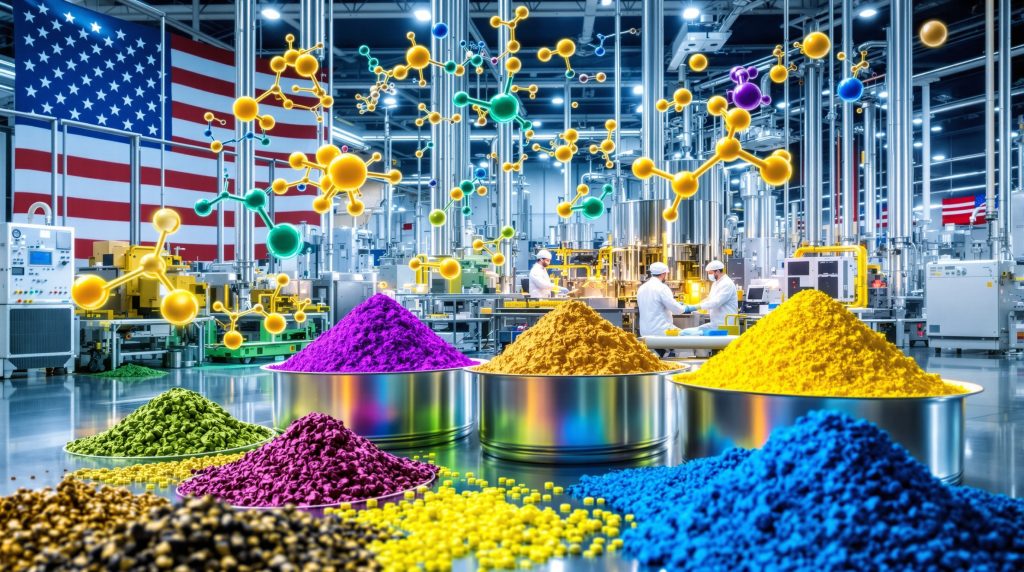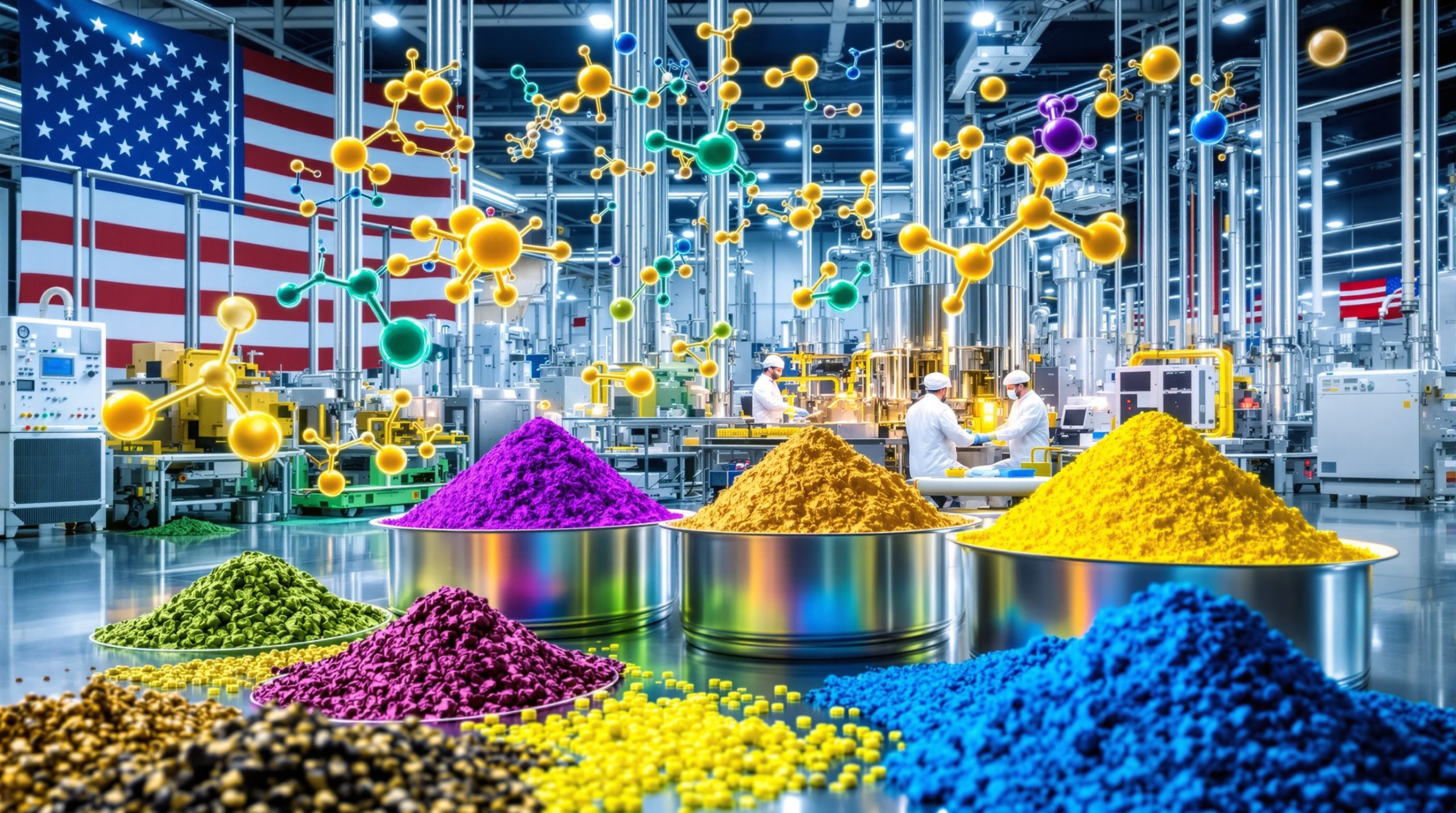How is the Noblesville Refinery Expansion Transforming U.S. Rare Earth Production?
The strategic expansion of ReElement Technologies' Noblesville facility represents a pivotal advancement in America's rare earth element (REE) processing capabilities. With a remarkable 141% increase in size, this Indiana-based facility now extends beyond 16,500 square feet and can produce more than 200 tonnes of refined materials annually. This development directly addresses critical vulnerabilities in domestic supply chains while positioning the United States to reduce its dependency on foreign sources for these essential materials.
The expansion comes at a crucial time as global competition for rare earth elements intensifies. These materials serve as fundamental components in numerous advanced technologies spanning defense systems, renewable energy infrastructure, and consumer electronics. By enhancing domestic production capabilities, the Noblesville refinery expansion for rare earth production contributes significantly to national security objectives while creating economic opportunities in high-tech manufacturing.
What Makes the Noblesville Expansion Strategically Important?
Scale and Capacity Enhancements
The facility's physical footprint has grown by 141%, providing substantially more space for advanced refining equipment and operational workflows. This increased square footage enables more efficient production processes and better separation of different elements during processing.
Production capacity has expanded to exceed 200 tonnes per annum (tpa) of refined materials, representing a significant boost to domestic supply capabilities. This volume allows ReElement to fulfill larger contracts with both defense contractors and commercial manufacturers.
The facility specializes in producing ultra-pure rare earth oxides with extraordinary purity levels ranging from 99.9% to 99.999%. These high-purity materials are essential for applications requiring precise performance specifications, particularly in defense and aerospace sectors.
Defense and Technology Applications
The expanded facility focuses specifically on critical defense elements including antimony, dysprosium, gadolinium, gallium, germanium, samarium, terbium, and yttrium. These materials are fundamental components in sophisticated defense systems including precision-guided weapons, night vision technology, radar systems, and communications equipment.
Commercial magnet elements like neodymium and praseodymium production has also been enhanced, supporting growing demand from renewable energy and electric vehicle manufacturers. These elements are essential for producing the high-performance permanent magnets used in wind turbines and electric motors.
The strategic focus on both defense and commercial applications ensures the facility can respond flexibly to market demands while supporting critical national security needs. This dual-purpose capability maximizes the facility's economic viability while serving strategic objectives.
What Technological Innovations Drive the Noblesville Facility?
Proprietary Refining Processes
The facility employs patented chromatography-based separation technology, representing a significant departure from traditional solvent extraction methods used in rare earth processing. This innovative approach allows for more precise separation of individual elements with higher efficiency.
Their liquid adsorption and desorption (LAD) methodology enables exceptional purity levels that meet or exceed industry standards. This process uses specialized resins to selectively capture specific elements from solution, allowing for precise separation even of elements with similar chemical properties.
The facility features a modular design that allows for rapid scaling and adaptation to changing market demands. This flexibility is particularly valuable in the rare earth market, where demand for specific elements can fluctuate based on technological innovations and global supply conditions.
Quality Control and Validation Systems
The expansion included integration of advanced ICP-MS (Inductively Coupled Plasma Mass Spectrometry) equipment, providing precise analytical capabilities to verify material purity and composition. This technology can detect trace impurities at parts-per-billion levels, ensuring consistent product quality.
Nine additional separation columns have been installed to enhance production capabilities, allowing for increased throughput and more efficient separation of specific rare earth elements. These columns represent a key component of the chromatography system that enables the high-purity outputs.
Sophisticated testing protocols have been implemented to ensure consistent commercial-grade output that meets strict industry specifications. These protocols include multiple quality checkpoints throughout the production process, guaranteeing reliability for defense and commercial applications.
How Does This Expansion Strengthen U.S. Supply Chain Resilience?
Reducing Foreign Dependency
The Noblesville expansion directly reduces American reliance on overseas processing facilities, particularly Chinese refineries which currently dominate global rare earth processing. China currently controls approximately 85% of global rare earth processing capacity, making this domestic capability critically important.
By creating domestic capacity for materials currently dominated by international suppliers, the facility helps insulate American manufacturers from potential supply disruptions due to geopolitical tensions or trade disputes. This increased self-sufficiency provides greater security for defense contractors and commercial technology companies.
The expansion establishes secure supply channels for defense-critical minerals, ensuring availability of materials needed for weapons systems, communications equipment, and other defense technologies. This critical minerals energy security is particularly important given increasing global competition for these resources.
Complementary Development Strategy
The Noblesville expansion represents part of a broader strategy that includes parallel development with the larger Marion Supersite facility. While Marion will eventually provide larger-scale production, the Noblesville expansion delivers immediate capacity increases.
Noblesville serves as a commercial validation center while maintaining daily operations, allowing for continuous production during technology refinement and scale-up. This approach minimizes production disruptions while new techniques are validated and improved.
Strategic equipment deployment across both facilities maximizes production efficiency and capital utilization. More than 60% of equipment for Marion's initial growth phase has already been ordered or is being installed, demonstrating coordinated planning between the facilities.
What Specific Materials Will the Expanded Facility Produce?
Critical Defense Elements
The facility has enhanced production capabilities for antimony, gallium, and germanium, which are classified as critical materials by the Department of Defense. Antimony is used in flame retardants, batteries, and ammunition; gallium in radar systems and LEDs; and germanium in infrared optics and fiber optics.
Specialized processing of heavy rare earths including dysprosium, terbium, and yttrium has been established. These elements are particularly valuable for defense applications, with dysprosium and terbium used in precision guidance systems and yttrium in defensive countermeasures.
Manufacturing capacity for gadolinium, samarium, and other defense-critical materials has been expanded. Gadolinium is used in magnetic resonance imaging and nuclear reactors, while samarium is essential for specialized magnets used in defense applications.
Commercial Applications
The facility maintains a strong focus on magnet-grade neodymium and praseodymium for renewable energy technologies. These elements are fundamental components of the permanent magnets used in wind turbines, electric vehicles, and other clean energy applications.
Battery material refining capabilities have been enhanced to support electric vehicle production and grid storage applications. While lithium remains the most discussed battery material, rare earths play important roles in various battery chemistries and associated electronics.
High-purity rare earth oxides for specialized electronics and communications equipment production has been prioritized. These materials enable miniaturization, improved performance, and enhanced durability in various electronic devices.
What Long-Term Impact Will This Expansion Have?
Market Positioning and Growth Strategy
The expansion provides immediate capacity increase while maintaining operational continuity, allowing ReElement to meet current customer demands while preparing for future growth. This approach minimizes disruption to existing supply relationships while expanding capabilities.
The facility's enhanced capabilities strategically position ReElement to fulfill defense industrial base requirements, supporting national security objectives through reliable domestic supply. This alignment with defense priorities helps secure long-term contracts and establish the company as a trusted supplier.
The expanded Noblesville facility provides a foundation for further expansion through the Marion facility development, establishing proof of concept and operational expertise that can be applied at larger scale. This staged approach reduces risk while building institutional knowledge.
Industry Leadership and Innovation
The expansion demonstrates scalable refining technology in a commercial setting, proving that domestic rare earth processing can be both technically viable and economically sustainable. This success challenges the conventional wisdom that rare earth processing must remain concentrated in Asia.
The facility validates domestic processing capabilities for critical minerals, showing that American companies can compete effectively in this strategic sector. This demonstration effect may encourage additional investment in domestic rare earth processing.
Through this expansion, ReElement establishes technical expertise in high-purity element separation that positions the company as an industry leader. This intellectual property and practical experience provides competitive advantages that extend beyond physical production capacity.
How is the Expansion Being Implemented?
Phased Development Approach
The expansion has been executed with concurrent operations and expansion to maintain production continuity. This approach allows the facility to continue serving existing customers while increasing capacity, avoiding disruptions to critical supply chains.
Strategic equipment acquisition and installation sequencing ensures optimal use of capital and minimizes production disruptions. By carefully planning the expansion timeline, ReElement has maintained operational capabilities throughout the development process.
Coordinated development between Noblesville and Marion facilities maximizes resources and ensures complementary capabilities. Equipment and expertise developed at Noblesville informs decisions about the larger Marion facility, creating synergies between the sites.
Operational Efficiency Improvements
The expanded facility features optimized workflow design that increases throughput and reduces processing time. Layout improvements minimize material handling and streamline production steps, enhancing overall productivity.
Enhanced quality control processes through advanced instrumentation ensure consistent product quality while reducing testing time. The addition of ICP-MS capabilities allows for rapid verification of material purity and composition.
Streamlined production protocols have been implemented for consistent high-purity outputs, reducing variability and improving yield. These standardized procedures enhance reliability while maintaining the flexibility to produce different material specifications.
What Future Developments Are Planned?
Marion Supersite Integration
The company reports that 60% of equipment for Marion's initial growth phase has already been ordered or is being installed, indicating significant progress toward larger-scale production. This procurement activity demonstrates commitment to the broader expansion strategy.
Planning for large-scale magnet-grade rare earth production at the Marion facility is underway, which will complement the capabilities at Noblesville. The larger facility will focus on higher-volume production of materials with established commercial demand.
Development of additional capacity for battery materials and defense elements at Marion will build upon expertise developed at Noblesville. This transfer of knowledge ensures consistent quality and performance across both facilities.
Production Scaling Roadmap
The near-term focus remains on defense and commercial high-purity materials at Noblesville, serving immediate market needs while the Marion facility develops. This approach maintains revenue generation while expanding capabilities.
Medium-term expansion of production volumes and material diversity is planned as both facilities reach full operational capability. This growth will allow ReElement to serve a broader range of customers and applications.
Long-term strategy envisions comprehensive rare earth element processing capabilities across both facilities, establishing ReElement as a leading domestic supplier. This full-spectrum approach will provide resilience against market fluctuations while serving strategic national interests.
FAQ: Noblesville Refinery Expansion
What is the significance of rare earth elements in modern technology?
Rare earth elements play a crucial role in numerous advanced technologies despite being used in relatively small quantities. They enable miniaturization of electronics, enhanced performance of renewable energy systems, and improved efficiency in various applications.
These elements are fundamental to permanent magnets used in electric vehicles and wind turbines, precision optics in medical and defense equipment, catalysts in petroleum refining, and phosphors in displays and lighting. Their unique properties often make them difficult to substitute with alternative materials.
The growing demand for clean energy technologies and advanced electronics has increased global competition for these materials, making domestic production capabilities strategically valuable both economically and for national security.
Why is domestic rare earth processing important for the United States?
Domestic processing reduces vulnerability to supply disruptions that could affect critical defense systems and commercial technologies. Current global supply chains are highly concentrated, with China controlling approximately 85% of processing capacity worldwide.
Processing capacity within the United States decreases dependence on foreign suppliers who may restrict exports during geopolitical tensions or prioritize their own domestic manufacturers during shortages. This independence is particularly important for defense applications.
Local processing creates economic opportunities in advanced manufacturing while reducing transportation costs and carbon emissions associated with global shipping of raw materials and finished products. This domestic production also enables greater quality control and intellectual property protection.
How does ReElement's technology differ from conventional rare earth processing?
Traditional rare earth processing typically relies on solvent extraction methods that are chemical-intensive, environmentally challenging, and require large physical footprints. ReElement's chromatography-based approach offers a more precise separation method with potentially lower environmental impact.
Conventional processing often struggles to achieve ultra-high purity levels efficiently, while ReElement's technology can produce materials with purities up to 99.999%. This capability is particularly valuable for advanced electronics and defense applications requiring exceptional material quality.
The modular nature of ReElement's technology allows for more flexible production scheduling and potentially faster adaptation to changing market demands compared to traditional facilities that are often optimized for specific material streams and output products.
What challenges exist in scaling rare earth element production?
Securing consistent, high-quality feedstock remains a significant challenge for processors. Whether sourcing from mining operations or recycling streams, variable input quality can affect processing efficiency and final product specifications.
Achieving economies of scale while maintaining product purity presents technical challenges, particularly for elements present in lower concentrations. As production volumes increase, maintaining precise separation becomes more complex and requires sophisticated process control.
Balancing production costs with market pricing pressures represents an ongoing challenge, particularly given competition from established international producers with potentially lower operating costs or government subsidies. This economic reality necessitates continued innovation in processing technology.
Environmental considerations and regulatory compliance requirements present additional complexities, particularly regarding waste management and water usage. Advanced processing facilities must meet increasingly stringent environmental standards while remaining economically competitive.
Further Exploration
The global rare earth market continues to evolve rapidly, with technological innovations driving both demand changes and processing improvements. Industry observers note that diversification of supply chains represents a critical priority for both governments and manufacturers dependent on these materials.
Environmental considerations remain central to discussions about rare earth processing, with newer technologies like those employed at Noblesville potentially offering improved sustainability compared to conventional methods. These advancements may help address historical concerns about the environmental impact of rare earth processing.
The integration of recycling into rare earth supply chains represents another important development area, with facilities like Noblesville potentially capable of processing both virgin materials and recycled content from end-of-life products. This critical minerals reserve approach could further strengthen supply chain resilience while reducing environmental impacts.
The Noblesville facility's focus on antimony processing also highlights growing interest in this strategic material. Recent investments in strategic antimony investment demonstrate the increasing importance of this element for both defense and commercial applications, further emphasizing the value of domestic processing capabilities.
As the mining industry evolution continues, facilities like the expanded Noblesville refinery will play an increasingly important role in ensuring secure access to the materials needed for advanced technologies and national defense. The integration of modern mining technology throughout the supply chain, from extraction to processing, will be essential for maintaining competitiveness in this strategic sector.
Want to Invest in the Next Major Mineral Discovery?
Discovery Alert's proprietary Discovery IQ model instantly notifies investors about significant ASX mineral discoveries, turning complex data into actionable insights for both short-term traders and long-term investors. Explore why major mineral discoveries can lead to exceptional returns by visiting Discovery Alert's dedicated discoveries page and position yourself ahead of the market.




